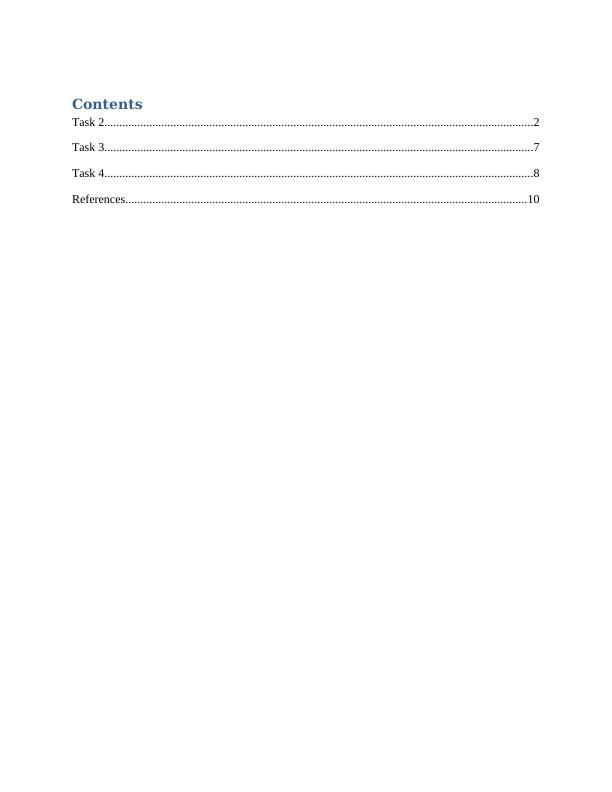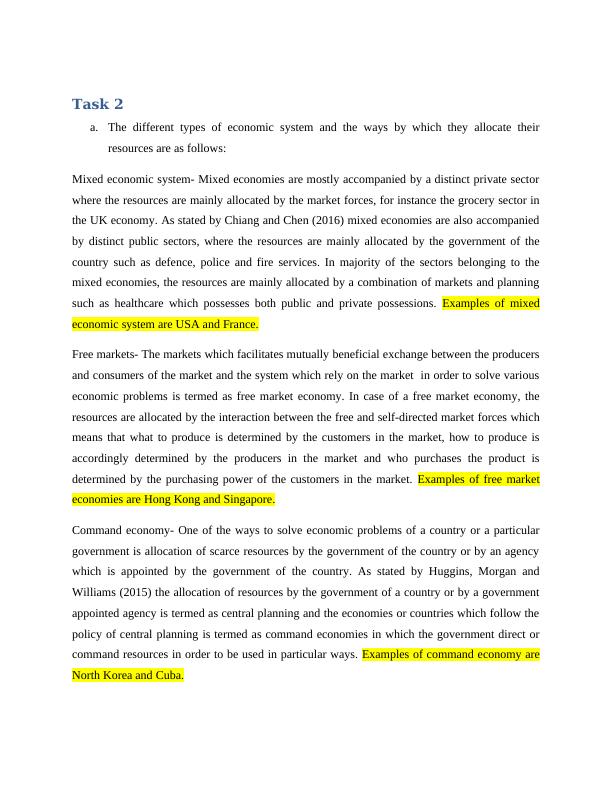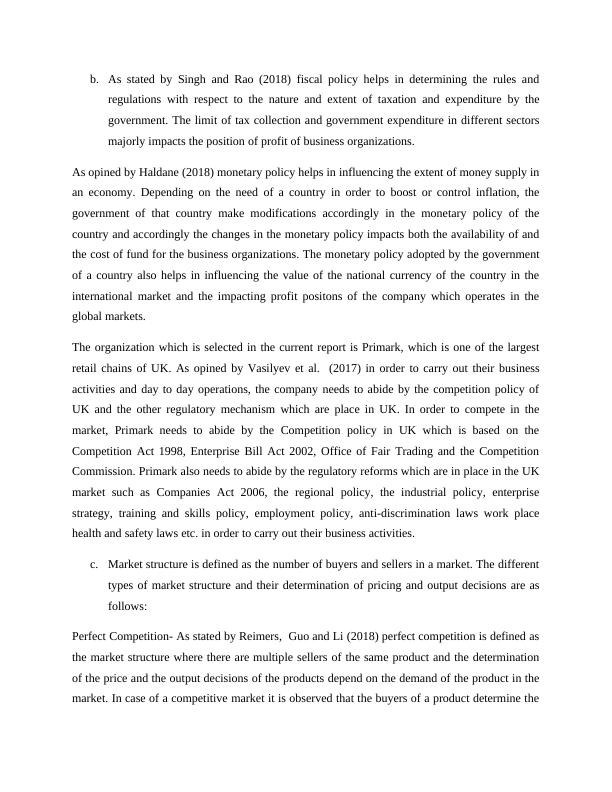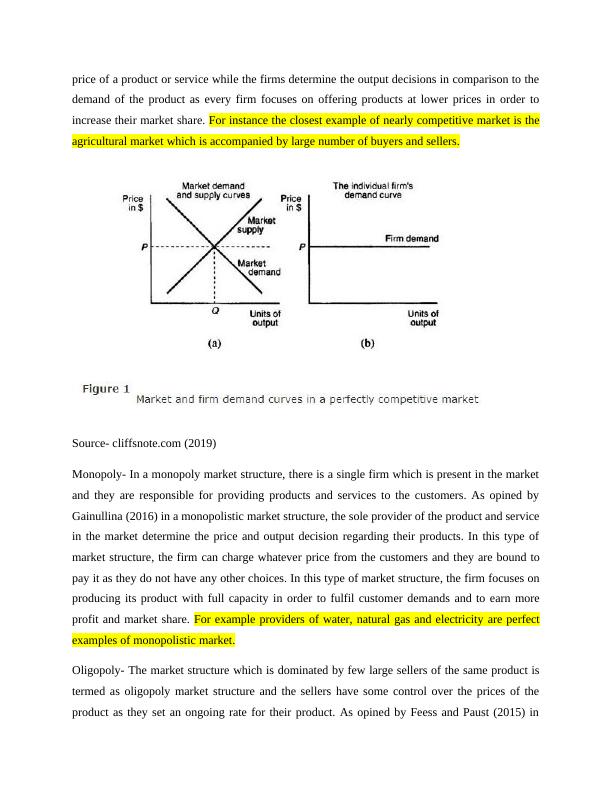Types of Economic Systems and their Resource Allocation
Added on 2023-01-11
12 Pages3597 Words61 Views
Contents
Task 2...............................................................................................................................................2
Task 3...............................................................................................................................................7
Task 4...............................................................................................................................................8
References......................................................................................................................................10
Task 2...............................................................................................................................................2
Task 3...............................................................................................................................................7
Task 4...............................................................................................................................................8
References......................................................................................................................................10

Task 2
a. The different types of economic system and the ways by which they allocate their
resources are as follows:
Mixed economic system- Mixed economies are mostly accompanied by a distinct private sector
where the resources are mainly allocated by the market forces, for instance the grocery sector in
the UK economy. As stated by Chiang and Chen (2016) mixed economies are also accompanied
by distinct public sectors, where the resources are mainly allocated by the government of the
country such as defence, police and fire services. In majority of the sectors belonging to the
mixed economies, the resources are mainly allocated by a combination of markets and planning
such as healthcare which possesses both public and private possessions. Examples of mixed
economic system are USA and France.
Free markets- The markets which facilitates mutually beneficial exchange between the producers
and consumers of the market and the system which rely on the market in order to solve various
economic problems is termed as free market economy. In case of a free market economy, the
resources are allocated by the interaction between the free and self-directed market forces which
means that what to produce is determined by the customers in the market, how to produce is
accordingly determined by the producers in the market and who purchases the product is
determined by the purchasing power of the customers in the market. Examples of free market
economies are Hong Kong and Singapore.
Command economy- One of the ways to solve economic problems of a country or a particular
government is allocation of scarce resources by the government of the country or by an agency
which is appointed by the government of the country. As stated by Huggins, Morgan and
Williams (2015) the allocation of resources by the government of a country or by a government
appointed agency is termed as central planning and the economies or countries which follow the
policy of central planning is termed as command economies in which the government direct or
command resources in order to be used in particular ways. Examples of command economy are
North Korea and Cuba.
a. The different types of economic system and the ways by which they allocate their
resources are as follows:
Mixed economic system- Mixed economies are mostly accompanied by a distinct private sector
where the resources are mainly allocated by the market forces, for instance the grocery sector in
the UK economy. As stated by Chiang and Chen (2016) mixed economies are also accompanied
by distinct public sectors, where the resources are mainly allocated by the government of the
country such as defence, police and fire services. In majority of the sectors belonging to the
mixed economies, the resources are mainly allocated by a combination of markets and planning
such as healthcare which possesses both public and private possessions. Examples of mixed
economic system are USA and France.
Free markets- The markets which facilitates mutually beneficial exchange between the producers
and consumers of the market and the system which rely on the market in order to solve various
economic problems is termed as free market economy. In case of a free market economy, the
resources are allocated by the interaction between the free and self-directed market forces which
means that what to produce is determined by the customers in the market, how to produce is
accordingly determined by the producers in the market and who purchases the product is
determined by the purchasing power of the customers in the market. Examples of free market
economies are Hong Kong and Singapore.
Command economy- One of the ways to solve economic problems of a country or a particular
government is allocation of scarce resources by the government of the country or by an agency
which is appointed by the government of the country. As stated by Huggins, Morgan and
Williams (2015) the allocation of resources by the government of a country or by a government
appointed agency is termed as central planning and the economies or countries which follow the
policy of central planning is termed as command economies in which the government direct or
command resources in order to be used in particular ways. Examples of command economy are
North Korea and Cuba.

b. As stated by Singh and Rao (2018) fiscal policy helps in determining the rules and
regulations with respect to the nature and extent of taxation and expenditure by the
government. The limit of tax collection and government expenditure in different sectors
majorly impacts the position of profit of business organizations.
As opined by Haldane (2018) monetary policy helps in influencing the extent of money supply in
an economy. Depending on the need of a country in order to boost or control inflation, the
government of that country make modifications accordingly in the monetary policy of the
country and accordingly the changes in the monetary policy impacts both the availability of and
the cost of fund for the business organizations. The monetary policy adopted by the government
of a country also helps in influencing the value of the national currency of the country in the
international market and the impacting profit positons of the company which operates in the
global markets.
The organization which is selected in the current report is Primark, which is one of the largest
retail chains of UK. As opined by Vasilyev et al. (2017) in order to carry out their business
activities and day to day operations, the company needs to abide by the competition policy of
UK and the other regulatory mechanism which are place in UK. In order to compete in the
market, Primark needs to abide by the Competition policy in UK which is based on the
Competition Act 1998, Enterprise Bill Act 2002, Office of Fair Trading and the Competition
Commission. Primark also needs to abide by the regulatory reforms which are in place in the UK
market such as Companies Act 2006, the regional policy, the industrial policy, enterprise
strategy, training and skills policy, employment policy, anti-discrimination laws work place
health and safety laws etc. in order to carry out their business activities.
c. Market structure is defined as the number of buyers and sellers in a market. The different
types of market structure and their determination of pricing and output decisions are as
follows:
Perfect Competition- As stated by Reimers, Guo and Li (2018) perfect competition is defined as
the market structure where there are multiple sellers of the same product and the determination
of the price and the output decisions of the products depend on the demand of the product in the
market. In case of a competitive market it is observed that the buyers of a product determine the
regulations with respect to the nature and extent of taxation and expenditure by the
government. The limit of tax collection and government expenditure in different sectors
majorly impacts the position of profit of business organizations.
As opined by Haldane (2018) monetary policy helps in influencing the extent of money supply in
an economy. Depending on the need of a country in order to boost or control inflation, the
government of that country make modifications accordingly in the monetary policy of the
country and accordingly the changes in the monetary policy impacts both the availability of and
the cost of fund for the business organizations. The monetary policy adopted by the government
of a country also helps in influencing the value of the national currency of the country in the
international market and the impacting profit positons of the company which operates in the
global markets.
The organization which is selected in the current report is Primark, which is one of the largest
retail chains of UK. As opined by Vasilyev et al. (2017) in order to carry out their business
activities and day to day operations, the company needs to abide by the competition policy of
UK and the other regulatory mechanism which are place in UK. In order to compete in the
market, Primark needs to abide by the Competition policy in UK which is based on the
Competition Act 1998, Enterprise Bill Act 2002, Office of Fair Trading and the Competition
Commission. Primark also needs to abide by the regulatory reforms which are in place in the UK
market such as Companies Act 2006, the regional policy, the industrial policy, enterprise
strategy, training and skills policy, employment policy, anti-discrimination laws work place
health and safety laws etc. in order to carry out their business activities.
c. Market structure is defined as the number of buyers and sellers in a market. The different
types of market structure and their determination of pricing and output decisions are as
follows:
Perfect Competition- As stated by Reimers, Guo and Li (2018) perfect competition is defined as
the market structure where there are multiple sellers of the same product and the determination
of the price and the output decisions of the products depend on the demand of the product in the
market. In case of a competitive market it is observed that the buyers of a product determine the

price of a product or service while the firms determine the output decisions in comparison to the
demand of the product as every firm focuses on offering products at lower prices in order to
increase their market share. For instance the closest example of nearly competitive market is the
agricultural market which is accompanied by large number of buyers and sellers.
Source- cliffsnote.com (2019)
Monopoly- In a monopoly market structure, there is a single firm which is present in the market
and they are responsible for providing products and services to the customers. As opined by
Gainullina (2016) in a monopolistic market structure, the sole provider of the product and service
in the market determine the price and output decision regarding their products. In this type of
market structure, the firm can charge whatever price from the customers and they are bound to
pay it as they do not have any other choices. In this type of market structure, the firm focuses on
producing its product with full capacity in order to fulfil customer demands and to earn more
profit and market share. For example providers of water, natural gas and electricity are perfect
examples of monopolistic market.
Oligopoly- The market structure which is dominated by few large sellers of the same product is
termed as oligopoly market structure and the sellers have some control over the prices of the
product as they set an ongoing rate for their product. As opined by Feess and Paust (2015) in
demand of the product as every firm focuses on offering products at lower prices in order to
increase their market share. For instance the closest example of nearly competitive market is the
agricultural market which is accompanied by large number of buyers and sellers.
Source- cliffsnote.com (2019)
Monopoly- In a monopoly market structure, there is a single firm which is present in the market
and they are responsible for providing products and services to the customers. As opined by
Gainullina (2016) in a monopolistic market structure, the sole provider of the product and service
in the market determine the price and output decision regarding their products. In this type of
market structure, the firm can charge whatever price from the customers and they are bound to
pay it as they do not have any other choices. In this type of market structure, the firm focuses on
producing its product with full capacity in order to fulfil customer demands and to earn more
profit and market share. For example providers of water, natural gas and electricity are perfect
examples of monopolistic market.
Oligopoly- The market structure which is dominated by few large sellers of the same product is
termed as oligopoly market structure and the sellers have some control over the prices of the
product as they set an ongoing rate for their product. As opined by Feess and Paust (2015) in

End of preview
Want to access all the pages? Upload your documents or become a member.
Related Documents
Assignment on Business Environment and Economic Systemlg...
|7
|1626
|253
Assignment on Economic Systems of IKEAlg...
|14
|5040
|370
Report on Business Environment of Nestle Companylg...
|12
|3930
|40
Business Environment | Essaylg...
|13
|4243
|190
Economics of Public Policy PDFlg...
|9
|2098
|52
Assignment | Business Environmentlg...
|11
|2721
|242
